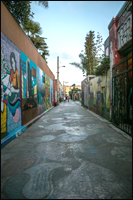Censorship of Public Art in Northern California
by Catherine Zhao
Research paper for Dartmouth College
What America was founded on and is the very basis of this country is freedom, especially the freedom of expression. Although we are allowed to talk freely about our dreams or practice our religions, the government still tends to suppress unfavorable ideas. Even in the form of creative expression, art, the U.S. government and those with power and money have the strength to choose which art is released to the public and which are to be destroyed. When Mexican muralists, such as Diego Rivera, David Alfaro Siqueiros, and José Clemente Orozco, were commissioned in the U.S., their works were heavily criticized, some eventually destroyed, for their radical and blunt illustrations of politics and Mexican and American culture. However, back in Mexico, these artists’ murals were freely presented to the public; even sacrilegious and communist images were painted in churches and schools. For example, Rivera’s Man at the Crossroads, which was controversial for its depiction of Lenin and Rivera’s support for the Soviet Union, was destroyed at the Rockefeller Center in New York City but preserved at the Palacio de Bellas Artes in Mexico City. The question of America’s hypocritical nature, pursuing freedom yet censoring the voices of some, during this time can be answered by the unstable economic state of the country during this period, where the nation’s strong nationalistic, democratic, capitalist foundations felt threatened by the Great Depression and by the rise of communism from around the world. Today, we can see the continuation of censorship of art. I will be analyzing the public art I have seen near my hometown of San Jose, California, in the cities of Palo Alto and San Francisco, to show how the socioeconomic states of each area heavily influences the type of art being acceptable in the community. In Palo Alto, the area is much more private, upper class and in San Francisco, the area is more public and socioeconomically diverse, and the art being displayed in each area reflects the amount of control the government or artist has over his or her own art, the types of people living there, and the access to the public walls that the local artists have for their works of public art.









